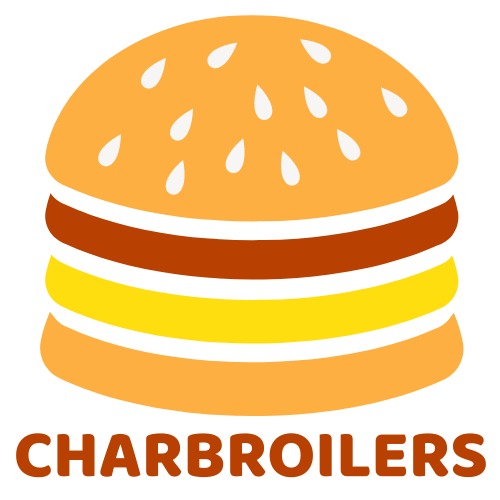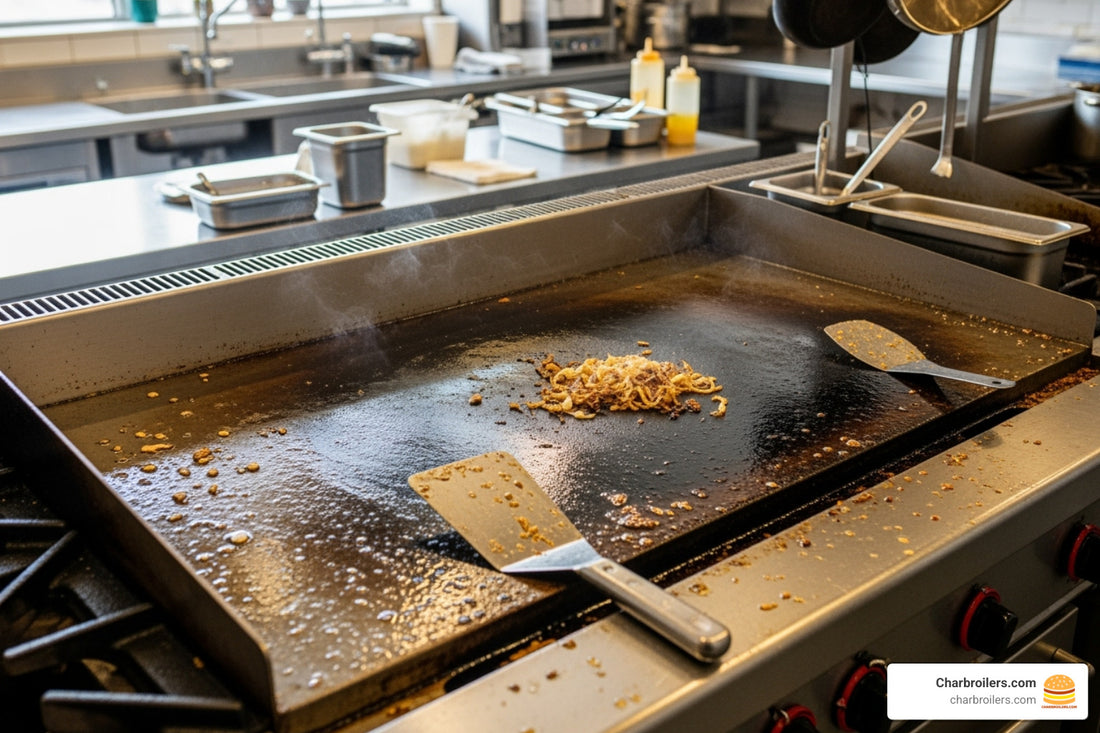
Griddle Glory: Simple Steps to a Spotless Surface
Share
Why a Clean Griddle is Your Kitchen's MVP
Learning how to clean a commercial griddle is essential for any restaurant's success. Here's a quick overview:
Daily Cleaning Steps:
- Cool to 300-350°F - Never use ice or cold water
- Scrape debris with a griddle scraper
- Apply cleaning solution for your surface type
- Scrub with a griddle brick (steel) or soft pad (chrome)
- Rinse with room-temperature water
- Season with a thin layer of cooking oil
A dirty griddle is a serious threat to your business. Grease buildup can harbor bacteria, cause flavor transfer between dishes, and create fire hazards. A dirty surface can also cause uneven heat transfer, making dinnertime beef taste like brunchtime chicken. This leads to lost customers and a damaged reputation.
The good news is that proper griddle cleaning takes just 3-5 minutes with the right system. A clean griddle ensures consistent heat, prevents equipment damage, and extends its lifespan.
I'm Sean Kearney from Charbroilers.com. With over a decade in the restaurant equipment industry, I've seen how proper maintenance is key to a kitchen's efficiency. Knowing how to clean your equipment is just as valuable as the equipment itself.
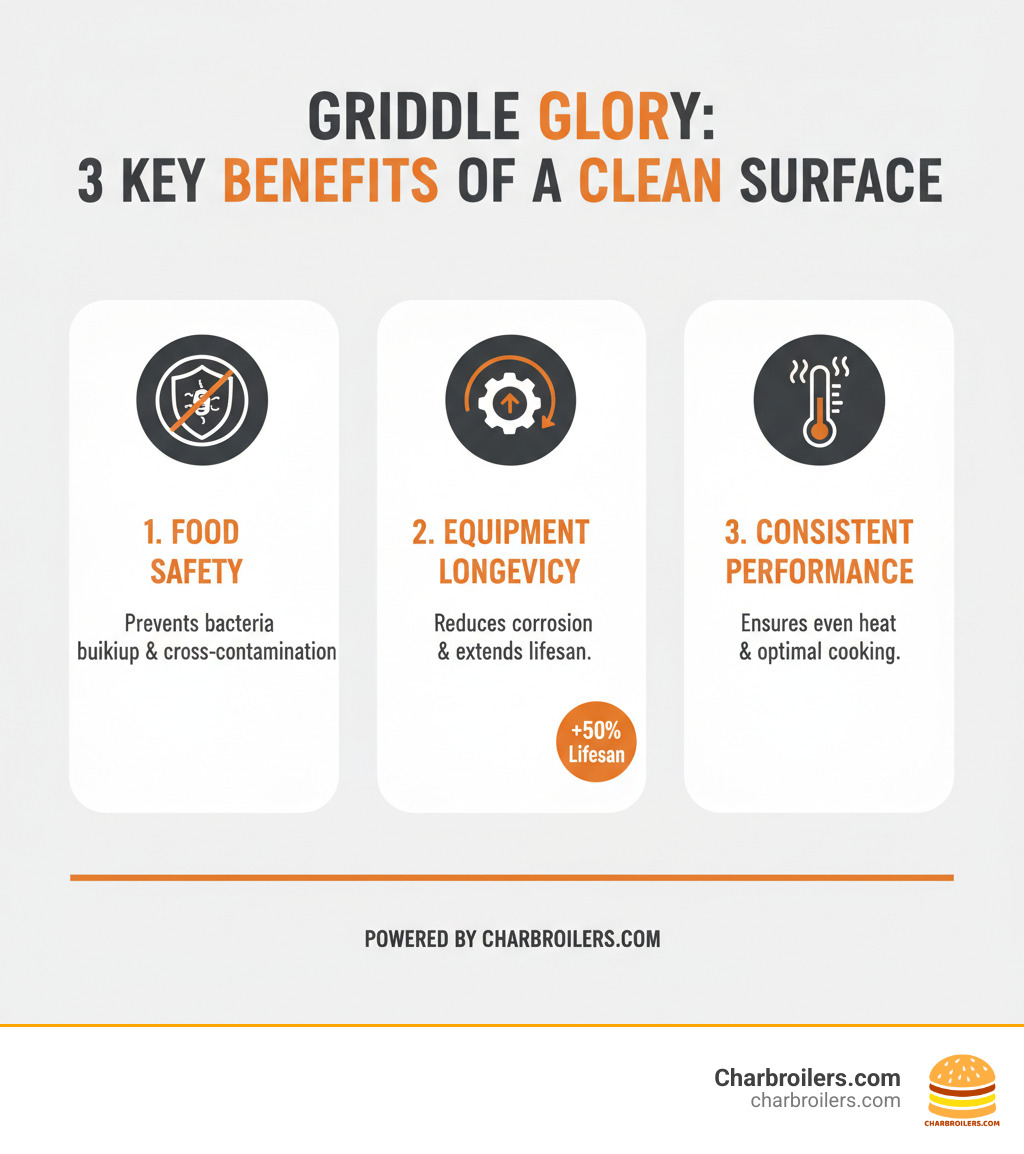
Explore more about how to clean a commercial griddle:
Prepping for the Perfect Clean: Tools and Griddle Types
Before you start cleaning your commercial griddle, make sure you have the right tools for the job. Using the wrong supplies can be ineffective and may even damage your equipment.
Essential Cleaning Tools and Supplies
Your griddle cleaning toolkit is key to maintaining a safe, efficient kitchen. Each tool has a specific purpose.
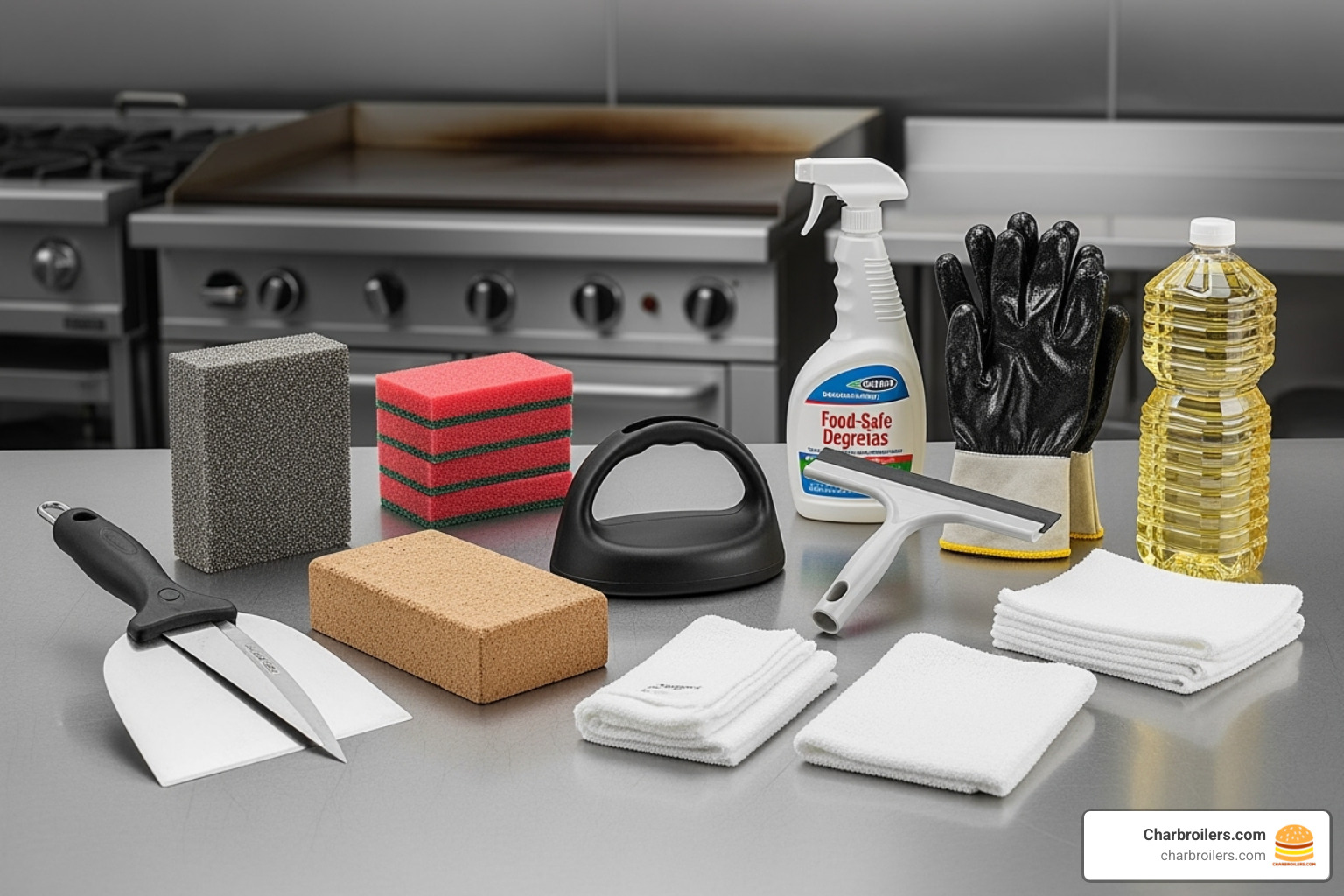
- Griddle scraper: A flat-blade tool to remove stuck-on food without scratching most surfaces.
- Griddle bricks or pumice stones: For steel surfaces, these scrub away stubborn carbon buildup.
- Non-abrasive scrub pads: Essential for delicate chrome and composite griddles. Use with a pad holder for safety and leverage.
- Heat-resistant gloves: A must-have for protecting your hands from heat and cleaning chemicals.
- Food-safe degreaser: A quality degreaser designed for griddles is more effective than household cleaners.
- Squeegee: Perfect for pushing liquids and debris into the grease trap.
- Clean cloths or microfiber towels: For final wiping and polishing.
- Cooking oil: Crucial for seasoning steel griddles after cleaning. Canola oil works well.
- Warm water: For rinsing. Never use cold water or ice on a hot griddle, as thermal shock can crack the surface.
- Safety equipment: Includes safety glasses to protect from hot liquids or steam.
Know Your Surface: Steel, Chrome, and Composite Griddles
Not all griddle surfaces are the same, and using the wrong cleaning method can void your warranty or damage your equipment.
| Feature | Steel Griddles | Chrome Griddles | Composite Griddles |
|---|---|---|---|
| Durability | Economical and durable, workhorse of the kitchen. | Durable, but surface is more delicate to abrasives. | Highly durable with advanced heat transfer technology. |
| Heat Emission | Emits more radiant heat into the kitchen. | Emits significantly less radiant heat, improving kitchen comfort. | Very low heat emission, higher energy efficiency. |
| Cleaning Ease | More labor-intensive due to porous surface and carbon buildup. | Easier to clean, less food sticking, faster cleanup. | Easiest to clean, advanced non-stick properties. |
| Cost | Most economical upfront. | More expensive than steel. | Highest upfront cost due to advanced technology. |
| Abrasive Use | Can withstand abrasive tools like griddle bricks. | AVOID ABRASIVES (grill bricks, scouring pads) – can scratch and void warranty. | Use non-abrasive pads only. |
| Performance | Good heat retention, but slower recovery. | Excellent heat retention, consistent cooking. | Fastest heat recovery, most consistent cook times. |
| Flavor Transfer | Higher risk if not cleaned carefully. | Low risk due to smoother surface. | Very low risk. |
Stainless steel griddles are the traditional workhorses. They're economical, durable, and can handle aggressive cleaning tools like griddle bricks to remove carbon buildup. However, they require more effort to clean and emit more heat.
Chrome griddles have a smooth, polished surface that reduces food sticking and makes cleanup faster. They also emit less radiant heat. Crucially, never use griddle bricks, scouring pads, or metal scrapers on chrome, as this will scratch the surface and void your warranty. Use soft pads or a palmetto brush instead.
Composite griddles are the cutting edge, transferring heat faster and recovering temperature quickly. Their advanced non-stick properties make them the easiest to clean. Like chrome, they require non-abrasive cleaning methods.
Understanding your griddle's material is about protecting your investment. If you're deciding which type is best for your operation, our guide to Commercial Gas Griddle options can help.
The bottom line: Match your cleaning method to your material for years of reliable service.
The Daily Grind: How to Clean a Commercial Griddle After Service
This daily procedure is the most effective way to keep your griddle in top condition. Consistent daily cleaning takes just 3-5 minutes but saves hours of scrubbing later and prevents major problems.
Step 1: Scrape and Degrease at the Right Temperature
The ideal temperature for cleaning is between 300-350°F. This keeps grease soft enough to remove easily without the cleaning solution evaporating too quickly. Let a hot griddle cool to this range, or briefly heat a cold one.
With heat-resistant gloves on, scrape away food debris using a griddle scraper. Push all loose particles and excess grease into the grease trough.
Next, apply your cleaning solution. For steel griddles, pour about a cup of room-temperature water or a food-safe griddle cleaner onto the hot surface to lift debris. For chrome or composite griddles, use a mild cleaning solution or warm, soapy water, as these surfaces are more delicate.
Important: Never use ice or cold water on a hot griddle. The rapid temperature change causes thermal shock, which can warp or crack your cooking surface permanently.
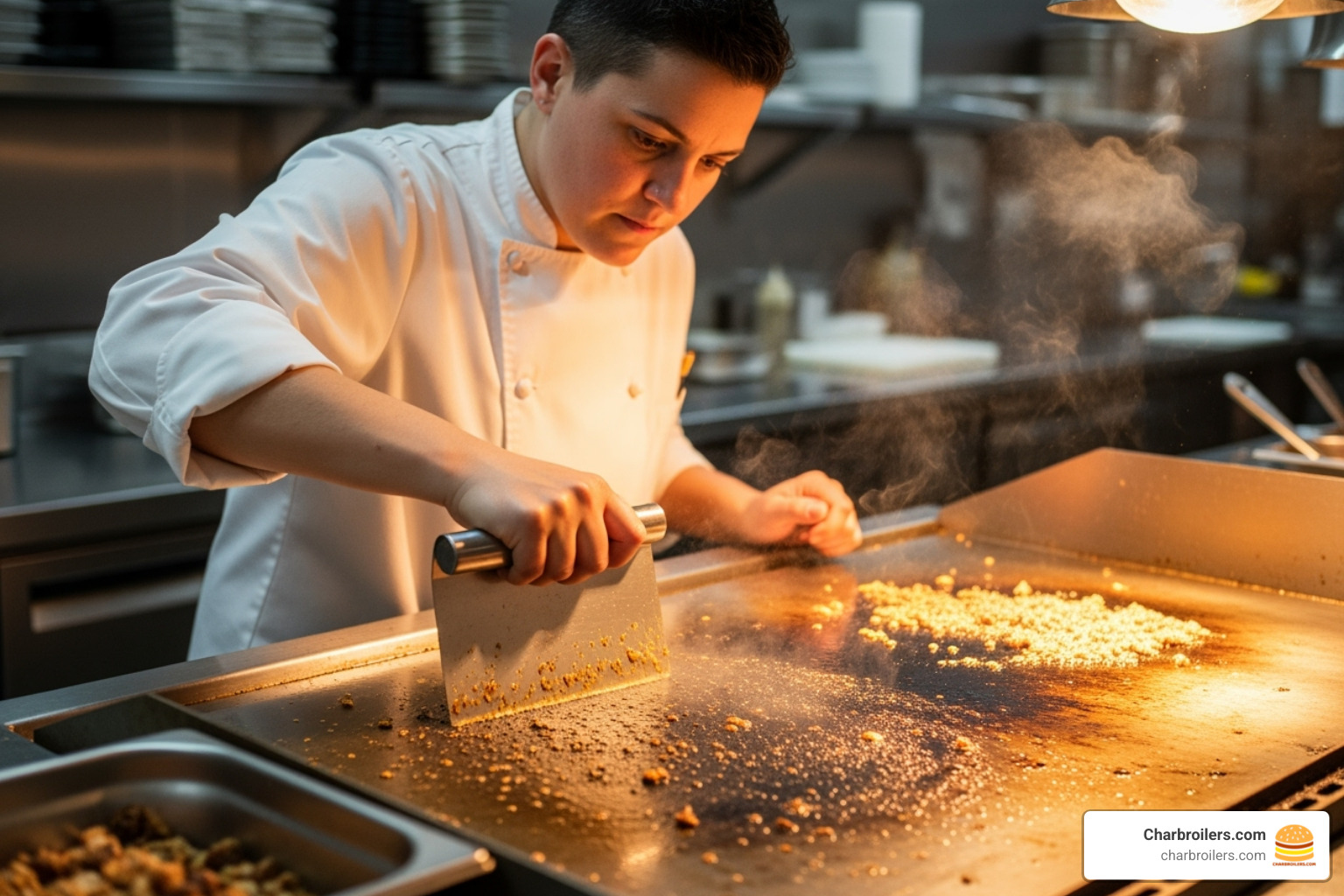
Step 2: Scrub, Rinse, and Squeegee for a Spotless Finish
Now it's time to scrub, matching your tool to the surface.
- For steel griddles: Use a griddle brick or pumice stone. Scrub in small circles to remove built-up grime.
- For chrome and composite surfaces: Use non-abrasive scrub pads or a palmetto brush to avoid scratching. A single scratch on chrome can void your warranty.
After scrubbing, rinse thoroughly with room-temperature water to flush away all cleaning agents and debris. Use a squeegee to push all liquid into the grease trough. Repeat until the water runs clear to prevent chemical residue from affecting food flavor.
Finally, empty and clean the grease trap daily. A full grease trap is a fire and pest hazard. Wash it with hot, soapy water and dispose of the grease properly.
Step 3: The Final Touch - How to Properly Season a Griddle After Cleaning
Seasoning protects your griddle, prevents rust, and creates a non-stick surface. Skipping this step leaves your griddle vulnerable.
Why seasoning matters: It prevents rust (especially on steel), creates a non-stick surface for easier cooking and cleanup, and can even improve food flavor over time.
To season, apply a few drops of high-smoke-point oil (like canola) to the warm (300-350°F) griddle. Use a clean, dry cloth to wipe away excess oil until the surface has only a very thin sheen. Too much oil will create a sticky, gummy mess.
Let the griddle heat for a few more minutes until you see a wisp of smoke. This indicates the oil has polymerized, forming a protective coating. Your griddle is now clean, protected, and ready for the next service.
For steel griddles specifically, our The Ultimate Guide to Cleaning a Commercial Stainless Steel Griddle offers more in-depth maintenance techniques.
Beyond the Basics: Deep Cleaning and Pro-Level Maintenance
Daily cleaning is crucial, but weekly deep cleans and preventive maintenance will dramatically extend your griddle's life. A well-cared-for griddle can last over 15 years, while neglected ones may fail in 5-7 years—a major difference to your bottom line.
Your Weekly Deep Cleaning Checklist
A weekly deep clean is more thorough than the daily routine and addresses often-overlooked spots.
- Cool the griddle completely for safe access to all components.
- Clean the exterior, including the backsplash, side splashes, and front panel, with a kitchen cleaner or warm, soapy water for a professional appearance.
- Sanitize high-touch areas like knobs and control panels, which are hotspots for bacteria.
- Inspect for wear and tear. Look for stress cracks, loose bolts, or other issues. Catching small problems early prevents equipment failure during a dinner rush.
- Deep clean the grease collection system. Remove and scrub all parts of the grease trough and collection system with a stiff brush and degreaser to clear hardened grease. A clogged system is a fire and health code hazard.
Pro Tips for Cleaning a Griddle During Service
Maintaining your griddle doesn't stop when the kitchen is busy.
Quick scraping between orders is a powerful habit. A 10-second scrape removes most residue before it can carbonize, making cleanup much easier.
For stubborn spots, sprinkle a few drops of room-temperature water onto the hot area. The steam helps lift debris for quick scraping without stopping service.
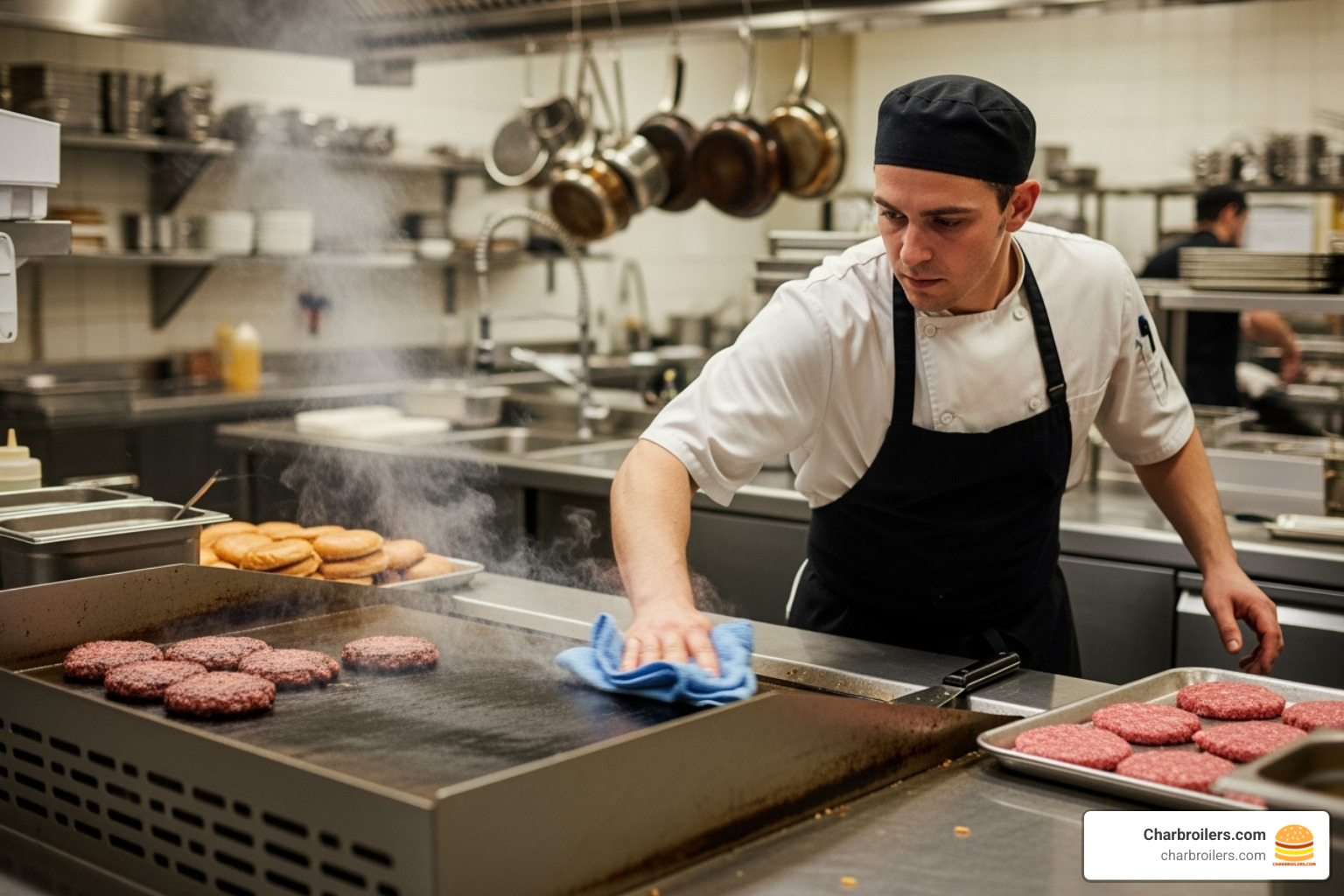
A clean surface ensures efficient heat transfer for consistent cooking results during rush periods. Quick scrapes also prevent flavor cross-contamination, ensuring each dish tastes as intended.
Preventive Maintenance and Professional Servicing
Regular maintenance is about protecting your investment. The benefits include consistent food quality, extended equipment life, cost savings, improved food safety, and better operational efficiency.
- Temperature Calibration: Check thermostats monthly to ensure accuracy. Incorrect temperatures affect food quality and energy use.
- Safety Inspections: For gas griddles, perform weekly leak checks. For electric griddles, inspect cords and connections monthly for damage.
- Professional Servicing: Schedule professional service twice a year. Experts can perform deeper diagnostics and maintain internal components, spotting issues you might miss.
This proactive approach saves on costly repairs and improves your bottom line. For a comprehensive look at all your kitchen equipment needs, explore our resources on Commercial Kitchen Equipment.
Frequently Asked Questions about Commercial Griddle Cleaning
Here are answers to the most common questions about how to clean a commercial griddle.
What are the biggest risks of not cleaning a commercial griddle?
A dirty griddle poses serious risks beyond just looking unprofessional:
- Food Safety Hazards: Leftover food and grease create a breeding ground for bacteria like salmonella and E. coli, which can cause foodborne illnesses.
- Fire Hazards: Grease buildup is highly flammable and a leading cause of kitchen fires.
- Flavor Transfer: Residue from previous orders can transfer to new dishes, resulting in unappetizing flavor combinations (e.g., fish-flavored pancakes).
- Equipment Damage: Carbon buildup and corrosion lead to uneven heating, higher energy costs, and premature equipment failure, shortening a griddle's lifespan from 10-15 years to just 3-5.
- Health Code Violations: A dirty griddle is a major red flag for health inspectors and can lead to fines or closures.
What's the best temperature to clean a griddle and can I use ice?
The ideal temperature for cleaning is 300-350°F (150-175°C). This is hot enough to keep grease soft but cool enough to work safely and prevent cleaning solutions from evaporating instantly.
Never use ice or cold water on a hot griddle. The extreme temperature change causes thermal shock, which can crack or warp the cooking surface. This is an expensive and irreversible mistake. Always use room-temperature water for rinsing.
How do I clean specific surfaces like chrome or stainless steel?
Different surfaces require different cleaning methods. Using the wrong one can cause damage and void your warranty.
- Stainless Steel: These durable surfaces can handle aggressive cleaning with griddle bricks and pumice stones to remove heavy carbon buildup. Always finish by seasoning with a thin layer of oil to prevent rust.
- Chrome: This surface is delicate and scratches easily. Do not use griddle bricks, metal scrapers, or other abrasives. Instead, use soft pads, palmetto brushes, and a food-safe griddle polish to clean and restore its shine.
- Composite: These advanced surfaces are easy to clean but also require gentle, non-abrasive methods. A mild detergent and a soft scrub pad are typically sufficient.
Always check your manufacturer's manual for specific cleaning recommendations to keep your warranty intact. Proper cleaning protects your investment, your customers, and your reputation.
Conclusion: A Clean Griddle is a Profitable Griddle
Mastering how to clean a commercial griddle is foundational to a successful restaurant. Every great dish starts with a clean, properly maintained cooking surface.
Consistent daily cleaning is key. A few minutes after each service prevents hours of future scrubbing, protects your investment, and ensures your food tastes exactly as it should. Remember the golden rule: match your cleaning method to the griddle's material. Using abrasive bricks on steel is fine, but chrome and composite surfaces require a gentle touch to avoid damage and voiding your warranty.
A clean griddle directly impacts your bottom line through:
- Food Safety: Protecting customers and your reputation.
- Optimal Performance: Ensuring consistent heat for perfectly cooked food.
- Equipment Longevity: Extending the life of your investment for years.
By preventing flavor transfer and fire hazards, you're not just cleaning—you're protecting your business. A well-maintained griddle runs more efficiently, uses less energy, and avoids costly emergency repairs.
Investing in quality equipment from Charbroilers.com is the first step. Proper care, using the techniques we've covered, will open up its full potential. Return the favor to your hard-working griddle with proper cleaning, and it will deliver the results that make your restaurant profitable.
To learn more about outfitting your kitchen for success, explore our guide to commercial charbroilers for your restaurant.
